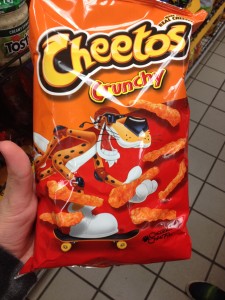Chester Cheetah seems to be another case of large, predatory cats, that are marketed to snack food and kids. Your first impression of the packaging is it’s eye attracting color scheme, focusing on vivid orange red and yellows. Chester is riding a skateboard and of course, eating a Cheeto. An anthropomorphic cheetah, Chester is savvy and smooth with a deep voice, with a memorable signature phrase. In a market filled with animals as mascots, a cheetah is still memorable and unique. You don’t buy Cheetos to be healthy and feel good about where they were processed and made. The false marketing scheme of labeling something as organic or grass fed isn’t possible with a snack food, which is good as it is marketing them without trying to forge a false clientele. I assume that other students in the class with right about dairy products with happy cows, which is a more twisted marketing scheme due to the cows falsely being associated with qualities such as happiness and freedom, which is ironic and misleading. I picked this product for another, more subtle reason. In the early 2000’s as CGI became relevant, Chester underwent a transformation from being a cool, sporty cat, to a more intellectual creature, often phrasing questions and philosophical debates in his ads. This further developed human-like cheetah is a staple in many households due to both crispy cheesy goodness and an identifiable mascot that is present in cupboards everywhere. It’s not directly false marketing, but it’s still as Foer describes, bullshit.
Instances of using animals as symbols for food is a long used tactic to appeal to younger demographics and draw upon customers natural tendency to like animals. Liking animals doesn’t make you buy Cheetos, but it certainly does make you look at Chester and ponder why they picked a Cheetah for their mascot. Is it because a cheetah is beloved in Western Culture? I do respect the marketing tactics employed by Cheetos as they don’t attempt to fit into a niche that they don’t occupy, it’s not healthy food and has never been marketed as healthy. Many products in a similar market such as Baked Lays and Pirates Booty attempt to reshape a snack-food into a more appealing, healthy alternative. The bag of Cheeto’s doesn’t say no trans fat or low sodium, but rather is says crunchy and cheesy. Of course variants of the original flavor exist, but Chester is omnipresent on every bag of crisps.
Chester is also smiling on the packaging, as he’s intended to be “fun” and sort of a pseudo pink panther. Cheeto’s is owned by Pepsi Co, and it’s evidenced through his changing slogans that their targeted demographic has slightly been altered over time. Firstly the slogan in the 1990’s was “It ain’t easy being cheesy,” to “The cheese with a crunch,” finally to “Dangerously Cheesy.” The terms Foer describes in detail such as Cruelty, and Desperation do not initially link to Chester, but looking deeper we can see their application. Negligence toward animals isn’t encouraged through Cheetos by any means, but it’s worth noting the hypothetical prison of a large predatory cat portraying cheesy, human junk food. The junk food market and cheetah’s truly have no overlap, but it’s a connection that gets kids excited to see a familiar face and character alike. I don’t think Cheeto’s does a bad job of marketing, it’s rather tame in comparison to other animals abused for young demographics. The fun loving Cheetah is both the fastest animal in the world, along with a symbol for popularized snack food, the two are distinctly separated but inherently linked together through modern marketing.
Just as a point of reference, I will link a 1990’s Cheeto’s add here: https://www.youtube.com/watch?v=dPH-UmXaaXs

Leave a Reply